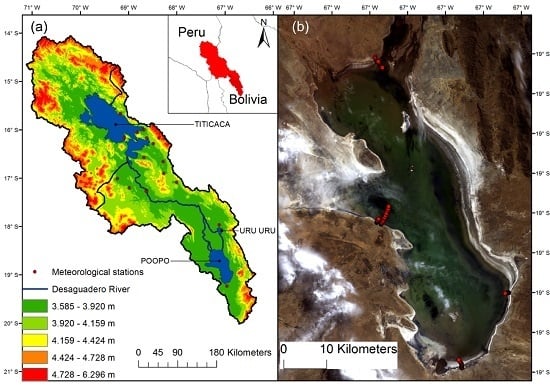Role of Climate Variability and Human Activity on Poopó Lake Droughts between 1990 and 2015 Assessed Using Remote Sensing Data
Abstract
:1. Introduction
2. Materials and Methods
2.1. Study Area
2.2. Data Used
2.2.1. Field Spectral Measurements
2.2.2. Landsat Imagery
2.2.3. Satellite Rainfall Estimates
2.2.4. MOD16 Global Evapotranspiration
2.3. Methods Used
2.3.1. FLAASH Atmospheric Correction
2.3.2. Satellite-Derived Indexes for Water Extraction
2.4. Assessment of Data and Method
2.4.1. L8SR and FLAASH Assessment
2.4.2. SDI Assessment
2.4.3. Satellite Rainfall and MOD16 Evapotranspiration Estimates Assessment
2.5. Temporal Analysis
2.5.1. Rain versus Superficial Lake Area
2.5.2. ETr, ETp and Rainfall Tendency over the Last 15 Years
3. Results and Discussion
3.1. Effects of Atmospheric Correction
3.2. SDI Assessment
3.3. Satellite Rainfall and MOD16 Evapotranspiration Estimates
3.4. Rainfall versus the Superficial Extent of the Lake
3.5. ETp, ETr and Rainfall Analysis
4. Conclusions
- (1)
- More accurate SR values are obtained after the FLAASH correction was applied on the Landsat scene than from the already atmospheric corrected LSR scene. One positive effect of both atmospheric correction methods is the decrease of the relative error between the bands. This effect is even more pronounced when considering SR derived from the FLAASH correction with lower %RMSE, %ME values and higher CC values for all the considered band ratios. Thus, FLAASH is recommended to pre-process Landsat imagery rather than the use of LSR product.
- (2)
- The AWEI, WRI and MNDWI were the most accurate SDIs over the region and only failed to classify mixed water and soil pixels. The NDVI and NDWI classified the shallower lake region as soil, which considerably underestimated the extent of Poopó Lake. The proposed threshold adjusted values enhance all SDIs efficiencies.
- (3)
- The two rainfall reanalysis products, PERSIANN-CDR and MSWEP, are accurate enough to represent regional monthly rainfall amount. Thus, using PERSIANN-CDR with MSWEP, the proposed MERGE monthly rainfall amount is even more suitable with a very low mean monthly bias value.
- (4)
- The low bias and high CC observed comparing MOD16 and reference ETp suggest that MOD16 ETr is accurate enough to represent regional monthly ETr.
Acknowledgments
Author Contributions
Conflicts of Interest
References
- López-Moreno, J.I.; Morán-Tejeda, E.; Vicente-Serrano, S.M.; Bazo, J.; Azorin-Molina, C.; Revuelto, J.; Sánchez-Lorenzo, A.; Navarro-Serrano, F.; Aguilar, E.; Chura, O. Recent temperature variability and change in the Altiplano of Bolivia and Peru. Int. J. Clim. 2015. [Google Scholar] [CrossRef]
- Seiler, C.; Hutjes, R.W.A.; Kabat, P. Climate variability and trends in Bolivia. J. Appl. Meteorol. Climatol. 2013, 52, 130–146. [Google Scholar] [CrossRef]
- Bradley, R.S.; Vuille, M.; Díaz, H.F.; Vergara, W. Threats to water supplies in the tropical Andes. Science 2006, 312, 1755–1756. [Google Scholar]
- Rabatel, A.; Francou, B.; Soruco, A.; Gomez, J.; Cceres, B.; Ceballos, J.L.; Basantes, R.; Vuille, M.; Sicart, J.E.; Huggel, C.; et al. Current state of glaciers in the tropical Andes: A multi-century perspective on glacier evolution and climate change. Cryosphere 2013, 7, 81–102. [Google Scholar] [CrossRef] [Green Version]
- Juen, I.; Kaser, G.; Georges, C. Modelling observed and future runoff from a glacierized tropical catchment (Cordillera Blanca, Perú). Glob. Planet. Chang. 2007, 59, 37–48. [Google Scholar] [CrossRef]
- Cusicanqui, J.; Dillen, K.; Garcia, M.; Geerts, S.; Raes, D.; Mathijs, E. Economic assessment at farm level of the implementation of deficit irrigation for quinoa production in the Southern Bolivian Altiplano. Span. J. Agric. Res. 2013, 11, 894. [Google Scholar] [CrossRef]
- Jacobsen, S.E. What is wrong with the sustainability of Quinoa production in Southern Bolivia—A reply to Winkel et al. (2012). J. Agron. Crop. Sci. 2012, 198, 320–323. [Google Scholar] [CrossRef]
- Jacobsen, S.-E. The situation for Quinoa and its production in Southern Bolivia: From economic success to environmental disaster. J. Agron. Crop. Sci. 2011, 197, 390–399. [Google Scholar] [CrossRef]
- Hadjimitsis, D.G.; Papadavid, G.; Agapiou, A.; Themistocleous, K.; Hadjimitsis, M.G.; Retalis, A.; Michaelides, S.; Chrysoulakis, N.; Toulios, L.; Clayton, C.R.I. Atmospheric correction for satellite remotely sensed data intended for agricultural applications: impact on vegetation indices. Nat. Hazards Earth Syst. Sci. 2010, 10, 89–95. [Google Scholar] [CrossRef]
- Agapiou, A.; Hadjimitsis, D.G.; Papoutsa, C.; Alexakis, D.D.; Papadavid, G. The Importance of accounting for atmospheric effects in the application of NDVI and interpretation of satellite imagery supporting archaeological research: The case studies of Palaepaphos and Nea Paphos sites in Cyprus. Remote Sens. 2011, 3, 2605–2629. [Google Scholar] [CrossRef]
- Song, C.; Woodcock, C.; Seto, K.C.; Lenney, M.P.; Macomber, S.A. Classification and change detection using Landsat TM Data—When and how to correct atmospheric effects? Remote Sens. Environ. 2001, 75, 230–244. [Google Scholar] [CrossRef]
- Rokni, K.; Ahmad, A.; Selamat, A.; Hazini, S. Water feature extraction and change detection using multitemporal landsat imagery. Remote Sens. 2014, 6, 4173–4189. [Google Scholar] [CrossRef]
- Zhai, K.; Wu, X.; Qin, Y.; Du, P. Comparison of surface water extraction performances of different classic water indices using OLI and TM imageries in different situations. Geo-Spat. Inf. Sci. 2015, 18, 32–42. [Google Scholar] [CrossRef]
- Arsen, A.; Crétaux, J.F.; Berge-Nguyen, M.; del Rio, R.A. Remote sensing-derived bathymetry of Poopó. Remote Sens. 2013, 6, 407–420. [Google Scholar] [CrossRef]
- Feyisa, G.L.; Meilby, H.; Fensholt, R.; Proud, S.R. Automated water extraction index: A new technique for surface water mapping using Landsat imagery. Remote Sens. Environ. 2014, 140, 23–35. [Google Scholar] [CrossRef]
- Fisher, A.; Flood, N.; Danaher, T. Remote Sensing of Environment Comparing Landsat water index methods for automated water classi fi cation in eastern Australia. Remote Sens. Environ. 2016, 175, 167–182. [Google Scholar] [CrossRef]
- Pillco, R.; Bengtsson, L. Long-term and extreme water level variations of the shallow Poopó, Bolivia Long-term and extreme water level variations of the shallow Poopó, Bolivia. Hydrol. Sci. J. 2006, 51, 98–114. [Google Scholar]
- Satgé, F.; Bonnet, M.P.; Timouk, F.; Calmant, S.; Pillco, R.; Molina, J.; Lavado-Casimiro, W.; Arsen, A.; Crétaux, J.F.; Garnier, J. Accuracy assessment of SRTM v4 and ASTER GDEM v2 over the Altiplano watershed using ICESat/GLAS data. Int. J. Remote Sens. 2015, 36, 465–488. [Google Scholar] [CrossRef]
- Satgé, F.; Bonnet, M.-P.; Gosset, M.; Molina, J.; Hernan Yuque Lima, W.; Pillco Zolá, R.; Timouk, F.; Garnier, J. Assessment of satellite rainfall products over the Andean plateau. Atmos. Res. 2016, 167, 1–14. [Google Scholar] [CrossRef]
- Garcia, M.; Raes, D.; Allen, R.; Herbas, C. Dynamics of reference evapotranspiration in the Bolivian highlands (Altiplano). Agric. For. Meteorol. 2004, 125, 67–82. [Google Scholar] [CrossRef]
- Mobley, C.D. Estimation of the remote-sensing reflectance from above-surface measurements. Appl. Opt. 1999, 38, 7442–7445. [Google Scholar] [CrossRef] [PubMed]
- Mishra, N.; Haque, M.O.; Leigh, L.; Aaron, D.; Helder, D.; Markham, B. Radiometric cross calibration of landsat 8 Operational Land Imager (OLI) and landsat 7 enhanced thematic mapper plus (ETM+). Remote Sens. 2014, 6, 12619–12638. [Google Scholar] [CrossRef]
- Li, P.; Jiang, L.; Feng, Z. Cross-comparison of vegetation indices derived from landsat-7 enhanced thematic mapper plus (ETM+) and landsat-8 operational land imager (OLI) sensors. Remote Sens. 2013, 6, 310–329. [Google Scholar] [CrossRef]
- She, X.; Zhang, L.; Cen, Y.; Wu, T.; Huang, C.; Baig, M.H.A. Comparison of the continuity of vegetation indices derived from Landsat 8 OLI and Landsat 7 ETM+ data among different vegetation types. Remote Sens. 2015, 7, 13485–13506. [Google Scholar] [CrossRef]
- Bryant, R.; Moran, M.S.; McElroy, S.; Holifield, C.; Thome, K.; Miura, T. Data continuity of Landsat-4 TM, Landsat-5 TM, Landsat-7 ETM+, and Advanced Land Imager (ALI) sensors. IEEE Int. Geosci. Remote Sens. Symp. 2002, 1, 584–586. [Google Scholar]
- Holifield, C.D.; McElroy, S.; Moran, M.S.; Bryant, R.; Miura, T.; Emmerich, W.E. Temporal and spatial changes in grassland transpiration detected using Landsat TM and ETM+ imagery. Can. J. Remote Sens. 2003, 29, 259–270. [Google Scholar] [CrossRef]
- Moran, M.; Bryant, R.; Thome, K.; Ni, W.; Nouvellon, Y.; Gonzalez-Dugo, M.; Qi, J.; Clarke, T. A refined empirical line approach for reflectance factor retrieval from Landsat-5 TM and Landsat-7 ETM+. Remote Sens. Environ. 2001, 78, 71–82. [Google Scholar] [CrossRef]
- Vogelmann, J.E.; Helder, D.; Morfitt, R.; Choate, M.J.; Merchant, J.W.; Bulley, H. Effects of Landsat 5 thematic mapper and Landsat 7 enhanced thematic mapper plus radiometric and geometric calibrations and corrections on landscape characterization. Remote Sens. Environ. 2001, 78, 55–70. [Google Scholar] [CrossRef]
- Masek, J.G.; Vermote, E.F.; Saleous, N.E.; Wolfe, R.; Hall, F.G.; Huemmrich, K.F.; Gao, F.; Kutler, J.; Lim, T.K. A landsat surface reflectance dataset for North America, 1990–2000. IEEE Geosci. Remote Sens. Lett. 2006, 3, 68–72. [Google Scholar] [CrossRef]
- Geological Survey: Provisionla Landsat 8 Surface Reflectance Code (LaSRC) Product. Available online: https://landsat.usgs.gov/sites/default/files/documents/provisional_lasrc_product_guide.pdf (accessed on 26 February 2017).
- Ashouri, H.; Hsu, K.L.; Sorooshian, S.; Braithwaite, D.K.; Knapp, K.R.; Cecil, L.D.; Nelson, B.R.; Prat, O.P. PERSIANN-CDR: Daily precipitation climate data record from multisatellite observations for hydrological and climate studies. Bull. Am. Meteorol. Soc. 2015, 96, 69–83. [Google Scholar] [CrossRef]
- Beck, H.E.; van Dijk, A.I.J.M.; Levizzani, V.; Schellekens, J.; Miralles, D.G.; Martens, B.; de Roo, A. MSWEP: 3-hourly 0.25° global gridded precipitation (1979–2015) by merging gauge, satellite, and reanalysis data. Hydrol. Earth Syst. Sci. Discuss. 2016, 2016, 1–38. [Google Scholar] [CrossRef]
- Funk, C.; Verdin, A.; Michaelsen, J.; Peterson, P.; Pedreros, P.; Husak, G. A global satellite-assisted precipitation climatology. Earth Syst. Sci. Data 2016, 7, 275–287. [Google Scholar] [CrossRef]
- Mu, Q.; Zhao, M.; Running, S.W. Improvements to a MODIS global terrestrial evapotranspiration algorithm. Remote Sens. Environ. 2011, 115, 1781–1800. [Google Scholar] [CrossRef]
- Mu, Q.; Heinsch, F.A.; Zhao, M.; Running, S.W. Development of a global evapotranspiration algorithm based on MODIS and global meteorology data. Remote Sens. Environ. 2007, 111, 519–536. [Google Scholar] [CrossRef]
- Friedl, M.A.; McIver, D.K.; Hodges, J.C.F.; Zhang, X.Y.; Muchoney, D.; Strahler, A.H.; Woodcock, C.E.; Gopal, S.; Schneider, A.; Cooper, A.; et al. Global land cover mapping from MODIS: Algorithms and early results. Remote Sens. Environ. 2002, 83, 287–302. [Google Scholar] [CrossRef]
- Myneni, R.B.; Hoffman, S.; Knyazikhin, Y.; Privette, J.L.; Glassy, J.; Tian, Y.; Wang, Y.; Song, X.; Zhang, Y.; Smith, G.R.; et al. Global products of vegetation leaf area and fraction absorbed PAR from year one of MODIS data. Remote Sens. Environ. 2002, 83, 214–231. [Google Scholar] [CrossRef]
- Jin, Y.; Schaaf, C.B.; Woodcock, C.E.; Gao, F.; Li, X.; Strahler, A.H.; Lucht, W.; Liang, S. Consistency of MODIS surface bidirectional reflectance distribution function and albedo retrievals: 2. Validation. J. Geophys. Res. 2003, 108, 4159. [Google Scholar] [CrossRef]
- Adler-Golden, S.M.; Matthew, M.W.; Bernstein, L.S.; Levine, R.Y.; Berk, A.; Richtsmeier, S.C.; Acharya, P.K.; Anderson, G.P.; Felde, J.W.; Gardner, J.A.; et al. Atmospheric correction for shortwave spectral imagery based on MODTRAN4. Imaging Spectrom. 1999, 3753, 61–69. [Google Scholar]
- Atmospheric Correction Module: QUAC and FLAASH User’s Guide; Harris Geospatial: Boulder, CO, USA, 2009.
- Mann, H.B. Nonparametric tests against trend. Econometrica 1945, 13, 163–171. [Google Scholar] [CrossRef]
- Burn, D.H.; Hag Elnur, M.A. Detection of hydrologic trends and variability. J. Hydrol. 2002, 255, 107–122. [Google Scholar] [CrossRef]
- Molina Carpio, J.; Satgé, F.; Pillco Zola, R. Water resources in the TDPS system. Available online: https://portals.iucn.org/library/sites/library/files/documents/2014-015.pdf (accessed on 26 February 2017).
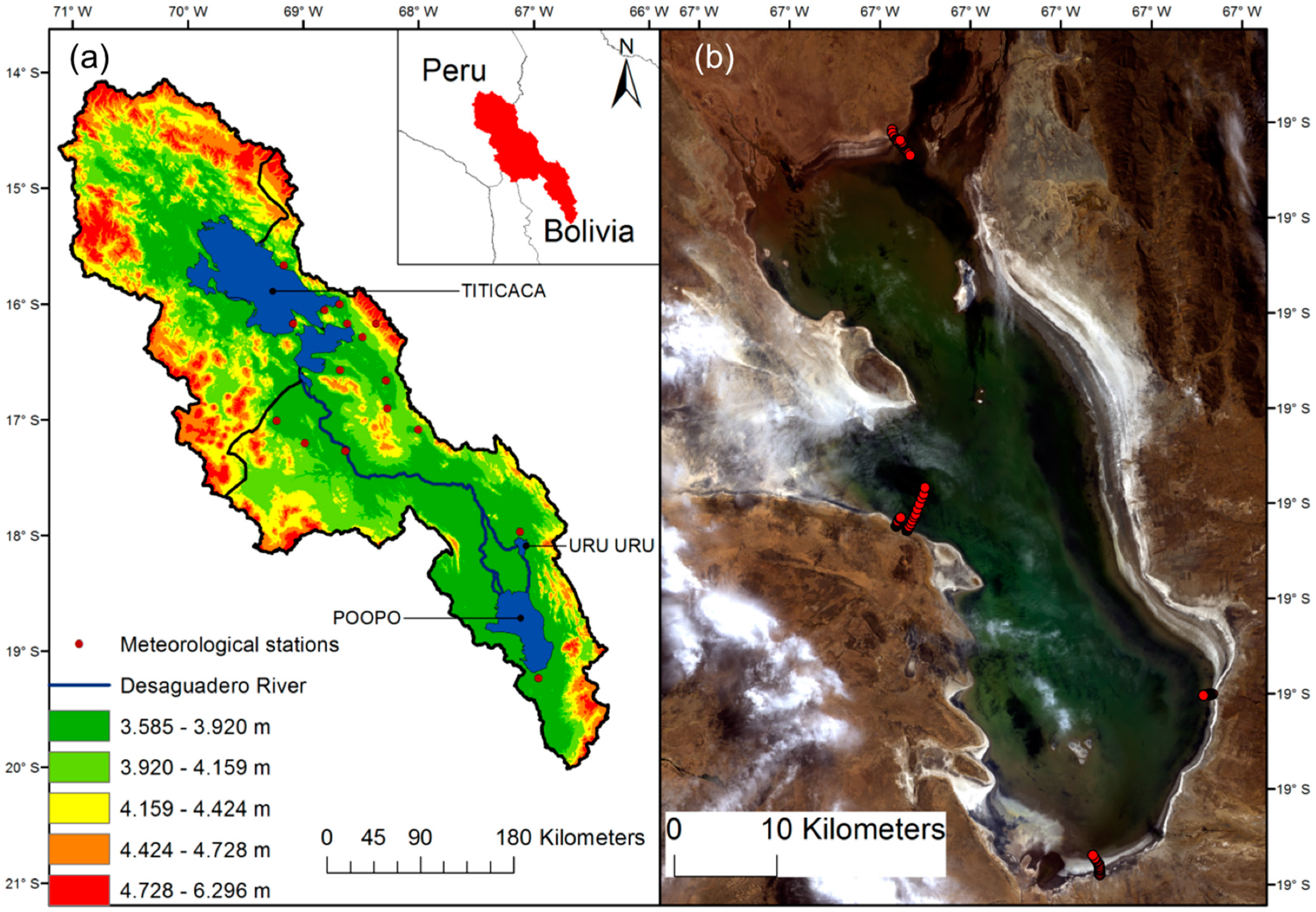
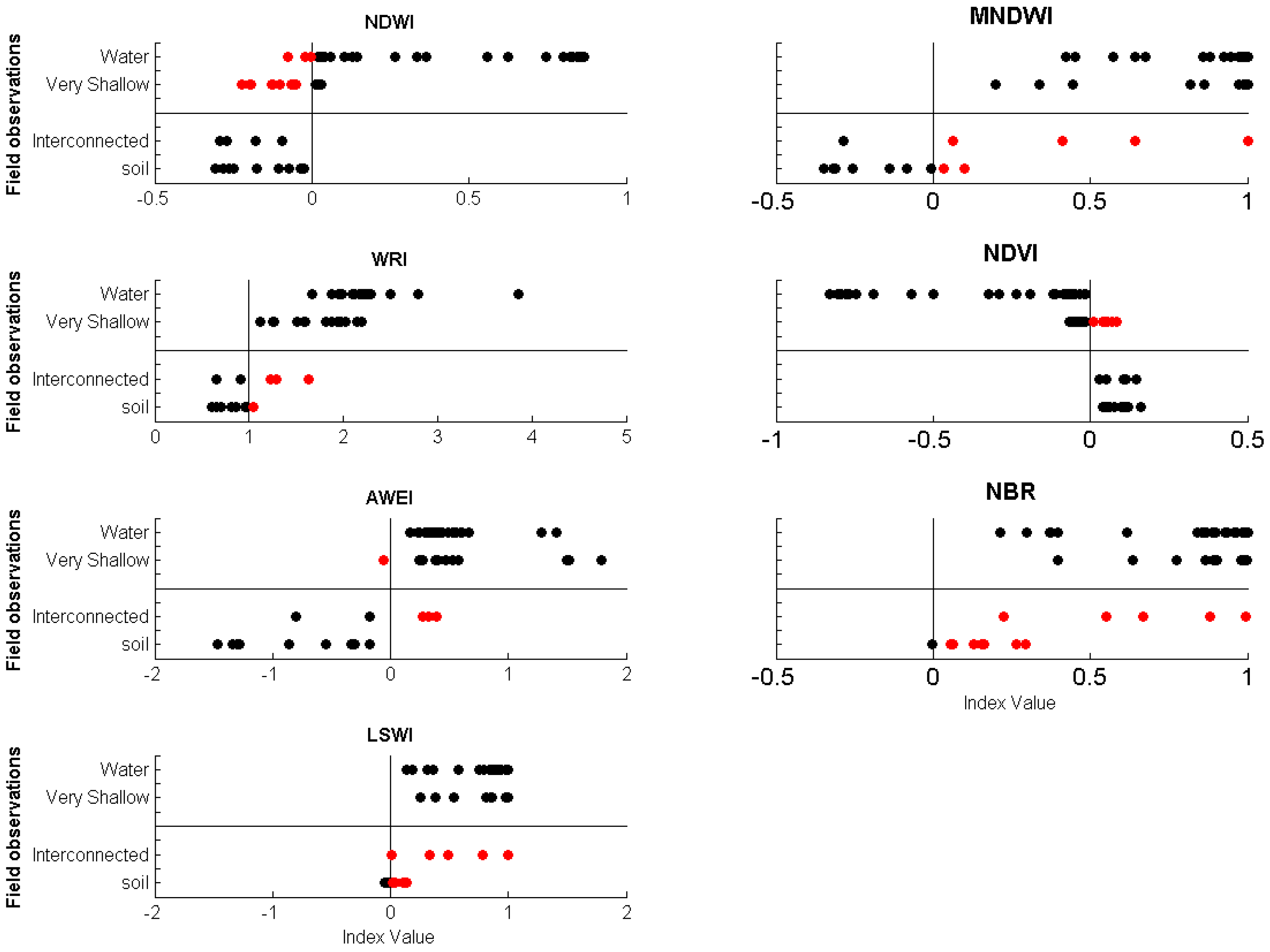
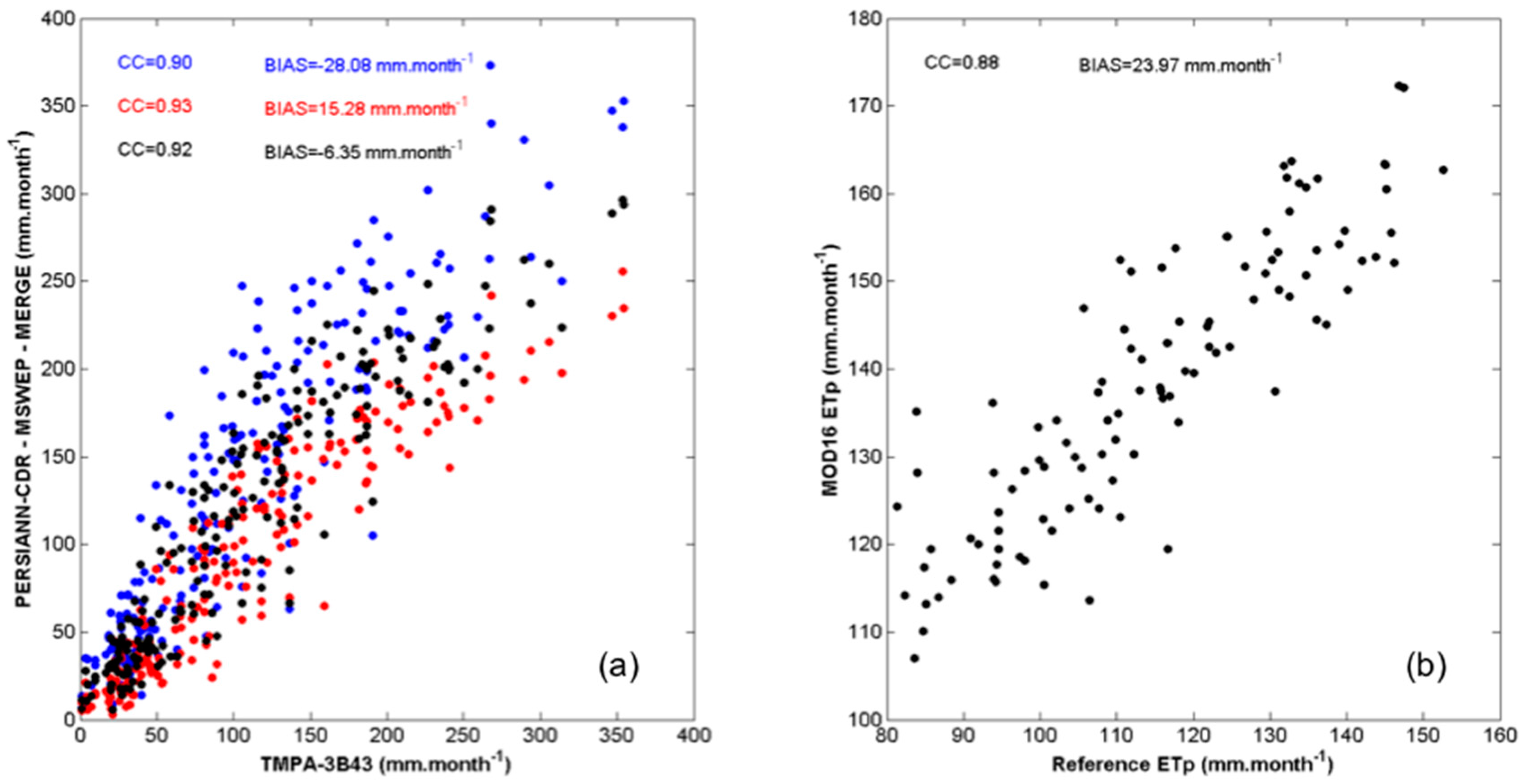

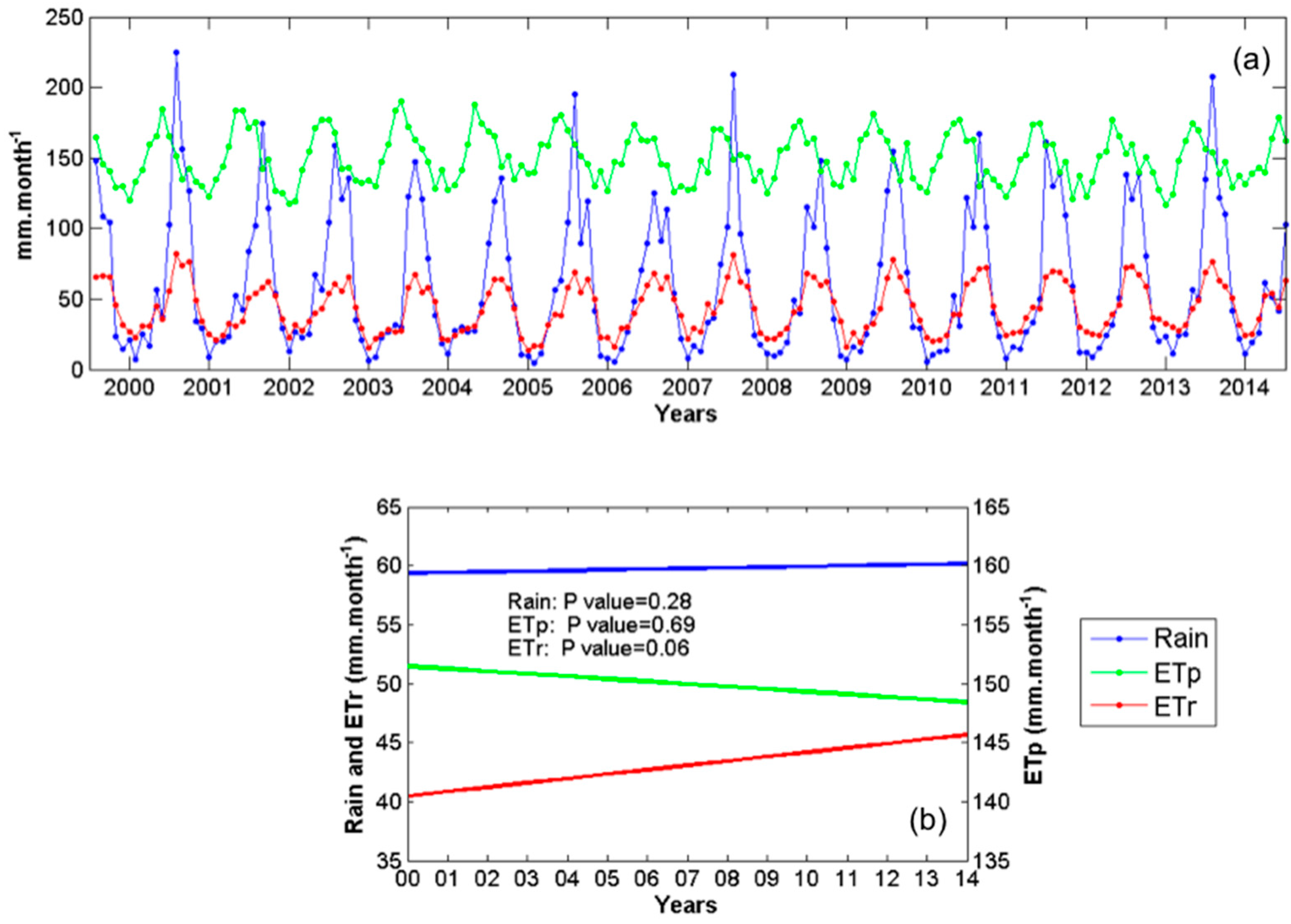

| Index | Equation | Threshold Value |
|---|---|---|
| Normalized Difference Water Index | NDWI = (Green − NIR)/(Green + NIR) | Water > 0 |
| Modified Normalized Difference Water Index | MNDWI = (Green − SWIR1)/(NIR + SWIR1) | Water > 0 |
| Water Ratio Index | WRI = (Green + Red)/(NIR + SWIR1) | Water > 1 |
| Normalized Difference Vegetation Index | NDVI = (NIR − Red)/(NIR + Red) | Water < 0 |
| Automated Water Extraction Index | AWEI = 4 × (Green − SWIR1) − (0.25 × NIR + 2.75 × SWIR2) | Water > 0 |
| Normalized Burn Ratio | NBR = (NIR − SWIR2)/(NIR + SWIR2) | Water > 0 |
| Land Surface Water Index | LSWI = (NIR − SWIR1)/(NIR + SWIR1) | Water > 0 |
| ME (%) | RMSE (%) | CC | |||||||
|---|---|---|---|---|---|---|---|---|---|
| Landsat | FLAASH | LSR | Landsat | FLAASH | LSR | Landsat | FLAASH | LSR | |
| Blue | 0.0 | −0.9 | −0.9 | 48.4 | 109.2 | 110.9 | 0.92 | 0.93 | 0.91 |
| Green | −0.2 | −0.9 | −0.9 | 44.0 | 102.7 | 103.7 | 0.91 | 0.92 | 0.91 |
| Red | −0.2 | −0.9 | −0.9 | 45.2 | 103.4 | 104.0 | 0.91 | 0.91 | 0.91 |
| Near IR | −0.1 | −0.9 | −0.9 | 57.8 | 115.1 | 115.6 | 0.84 | 0.84 | 0.84 |
| Green/Red | 0.0 | 0.0 | 0.0 | 13.1 | 5.0 | 6.5 | 0.94 | 0.98 | 0.97 |
| Blue/Green | 0.4 | 0.1 | 0.0 | 38.6 | 9.4 | 12.4 | 0.47 | 0.88 | 0.69 |
| Red/Blue | −0.3 | 0.0 | 0.0 | 41.9 | 10.9 | 15.6 | 0.75 | 0.96 | 0.89 |
| Blue/Infra-Red | −0.5 | −0.1 | −4.0 | 122.1 | 46.3 | 2663.3 | 0.90 | 0.93 | −0.35 |
| Red/Infra-Red | −0.6 | −0.1 | −3.8 | 118.5 | 45.3 | 2512.3 | 0.87 | 0.92 | −0.37 |
| Green/Infra-Red | −0.7 | −0.1 | −4.4 | 137.2 | 50.1 | 2896.3 | 0.88 | 0.93 | −0.38 |
| SDI Observation | |||
|---|---|---|---|
| Water | Land | ||
| Field Observation | Water | Ok | Outlier |
| Land | Outlier | Ok | |
| SDI | Default Threshold Value | Outlier Number | Superficial (km2) | Recommended Threshold Value | Outlier Number | Superficial (km2) |
|---|---|---|---|---|---|---|
| NDWI | 0 | 14 | 1204 | −0.0235 | 12 | 1314 |
| MNDWI | 0 | 6 | 1664 | 0.15 | 3 | 1477 |
| WRI | 1 | 4 | 1570 | 1.05 | 3 | 1497 |
| NDVI | 0 | 7 | 1160 | 0.025 | 6 | 1208 |
| AWEI | 0 | 4 | 1454 | −0.1 | 3 | 1454 |
| NBR | 0 | 13 | 2627 | 0.21 | 7 | 1906 |
| LSWI | 0 | 10 | 2099 | 0.05 | 6 | 1820 |
© 2017 by the authors. Licensee MDPI, Basel, Switzerland. This article is an open access article distributed under the terms and conditions of the Creative Commons Attribution (CC BY) license ( http://creativecommons.org/licenses/by/4.0/).
Share and Cite
Satgé, F.; Espinoza, R.; Zolá, R.P.; Roig, H.; Timouk, F.; Molina, J.; Garnier, J.; Calmant, S.; Seyler, F.; Bonnet, M.-P. Role of Climate Variability and Human Activity on Poopó Lake Droughts between 1990 and 2015 Assessed Using Remote Sensing Data. Remote Sens. 2017, 9, 218. https://doi.org/10.3390/rs9030218
Satgé F, Espinoza R, Zolá RP, Roig H, Timouk F, Molina J, Garnier J, Calmant S, Seyler F, Bonnet M-P. Role of Climate Variability and Human Activity on Poopó Lake Droughts between 1990 and 2015 Assessed Using Remote Sensing Data. Remote Sensing. 2017; 9(3):218. https://doi.org/10.3390/rs9030218
Chicago/Turabian StyleSatgé, Frédéric, Raúl Espinoza, Ramiro Pillco Zolá, Henrique Roig, Franck Timouk, Jorge Molina, Jérémie Garnier, Stéphane Calmant, Frédérique Seyler, and Marie-Paule Bonnet. 2017. "Role of Climate Variability and Human Activity on Poopó Lake Droughts between 1990 and 2015 Assessed Using Remote Sensing Data" Remote Sensing 9, no. 3: 218. https://doi.org/10.3390/rs9030218






